
Scenes from the Life of the Virgin Mary (Italian - Le Storie della Vergine) is a cycle of frescos by Filippo Lippi in Spoleto Cathedral.

Scenes from the Life of the Virgin Mary (Italian - Le Storie della Vergine) is a cycle of frescos by Filippo Lippi in Spoleto Cathedral.
The cycle was commissioned in 1466, when Lippi had completed his Stories of Saint Stephen and Saint John the Baptist at Prato Cathedral, and was abruptly terminated by Lippi's death in 1469, caused by poison according to Vasari's Lives of the Artists . His studio assistants completed the work in around three months. Lippi was buried in Spoleto Cathedral despite Lorenzo the Magnificent's request for the remains to be returned to Florence - Spoleto replied that unlike Florence their great new cathedral had no illustrious men buried in it.
From left to right the cycle shows:

Filippino Lippi was an Italian Renaissance painter mostly working in Florence, Italy during the later years of the Early Renaissance and first few years of the High Renaissance. He also worked in Rome for a period from 1488, and later in the Milan area and Bologna.

Lorenzo Monaco was a Sienese painter and miniaturist of the late Gothic to early Renaissance age, active principally in Florence. He was born Piero di Giovanni. Little is known about his youth, apart from the fact that he was apprenticed in Florence. He has been considered the last important exponent of the Giotto style, before the Renaissance revolution that came with Fra Angelico and Masaccio.
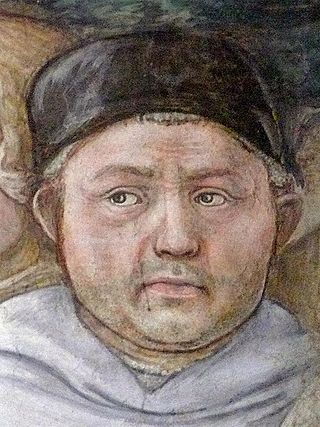
Filippo Lippi, also known as Lippo Lippi, was an Italian Renaissance painter of the Quattrocento and a Carmelite priest. He was an early Renaissance master of a painting workshop, who taught many painters. Sandro Botticelli and Francesco di Pesello were among his most distinguished pupils. His son, Filippino Lippi, also studied under him and assisted in some late works.

Fra Diamante was an Italian Renaissance painter.

Ridolfo di Domenico Bigordi, better known as Ridolfo Ghirlandaio was an Italian Renaissance painter active mainly in Florence. He was the son of Domenico Ghirlandaio.

Spoleto Cathedral is the cathedral of the Archdiocese of Spoleto-Norcia created in 1821, previously that of the diocese of Spoleto, and the principal church of the Umbrian city of Spoleto, in Italy. It is dedicated to the Assumption of the Blessed Virgin Mary.
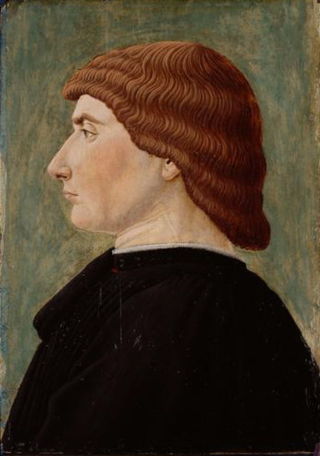
Fra Carnevale OP was an Italian painter of the Quattrocento, active mainly in Urbino. Widely regarded as one of the most enigmatic artists, there are only nine works that can be definitively attributed to Carnevale known of today. Most of these have even been contested as authentic to Carnevale at various points in history.
The decade of the 1450s in art involved many significant events, especially in sculpture.
The decade of the 1440s in art involved some significant events.
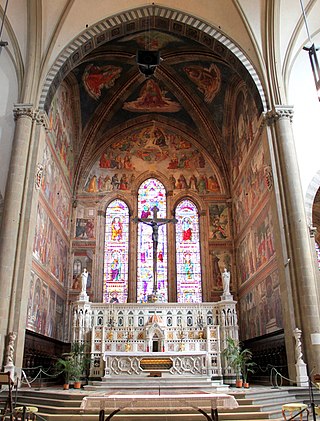
The Tornabuoni Chapel is the main chapel in the church of Santa Maria Novella, Florence, Italy. It is famous for the extensive and well-preserved fresco cycle on its walls, one of the most complete in the city, which was created by Domenico Ghirlandaio and his workshop between 1485 and 1490.

The Coronation of the Virgin or Coronation of Mary is a subject in Christian art, especially popular in Italy in the 13th to 15th centuries, but continuing in popularity until the 18th century and beyond. Christ, sometimes accompanied by God the Father and the Holy Spirit in the form of a dove, places a crown on the head of Mary as Queen of Heaven. In early versions the setting is a Heaven imagined as an earthly court, staffed by saints and angels; in later versions Heaven is more often seen as in the sky, with the figures seated on clouds. The subject is also notable as one where the whole Christian Trinity is often shown together, sometimes in unusual ways. Crowned Virgins are also seen in Eastern Orthodox Christian icons, specifically in the Russian Orthodox church after the 18th century. Mary is sometimes shown, in both Eastern and Western Christian art, being crowned by one or two angels, but this is considered a different subject.

The Nativity of Jesus has been a major subject of Christian art since the 4th century.
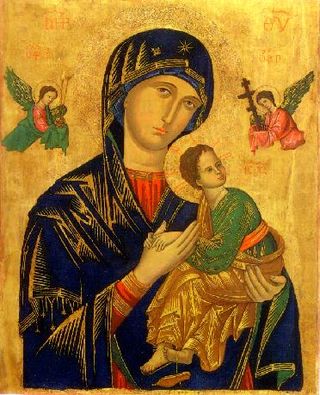
Mary has been one of the major subjects of Western art for centuries. There is an enormous quantity of Marian art in the Catholic Church, covering both devotional subjects such as the Virgin and Child and a range of narrative subjects from the Life of the Virgin, often arranged in cycles. Most medieval painters, and from the Reformation to about 1800 most from Catholic countries, have produced works, including old masters such as Michelangelo and Botticelli.

The Coronation of the Virgin is a painting of the Coronation of the Virgin by the Italian Renaissance master Filippo Lippi, in the Uffizi, Florence.

The Barbadori Altarpiece is a polyptych painting by Filippo Lippi, commissioned in 1437 and completed in 1438. It consists of a main panel followed by a predella. The main panel, Virgin and Child Surrounded by Angels with St. Frediano and St. Augustine, is a sacra conversazione that contains flow between each figure to depict a coronation.
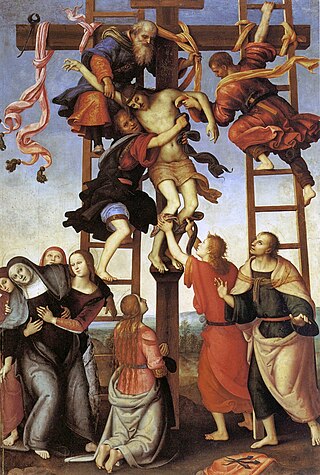
The Annunziata Polyptych is a painting cycle started by Filippino Lippi and finished by Pietro Perugino, whose central panel is now divided between the Galleria dell'Accademia and the Basilica dell'Annunziata, both in Florence, Italy. The polyptych had other six panels, which are housed in the Lindenau-Museum of Altenburg, the Metropolitan Museum of New York City, the Galleria Nazionale d'Arte Antica in Rome and in a private collection in South Africa.

The Apparition of Christ to the Virgin is a painting by the Italian Renaissance master Filippino Lippi, executed around 1493 and now housed in the Alte Pinakothek of Munich, Germany.

The Palazzo Pretorio is a historical building in Prato, Tuscany, Italy. It was the old city hall, standing in front of the current Palazzo Comunale. It now accommodates the Civic Museum of Prato, which was reopened in September 2013.

The Stories of Saint Stephen and Saint John the Baptist is a fresco cycle by the Italian Renaissance painter Filippo Lippi and his assistants, executed between 1452 and 1465. It is located in the Great Chapel of the Cathedral of Prato, Italy.

Domenico di Zanobi, formerly known as the Master of the Johnson Nativity, was an Italian Renaissance painter. His exact dates of birth and death are not known. He is documented as a mature artist from 1467 until 1481.